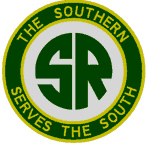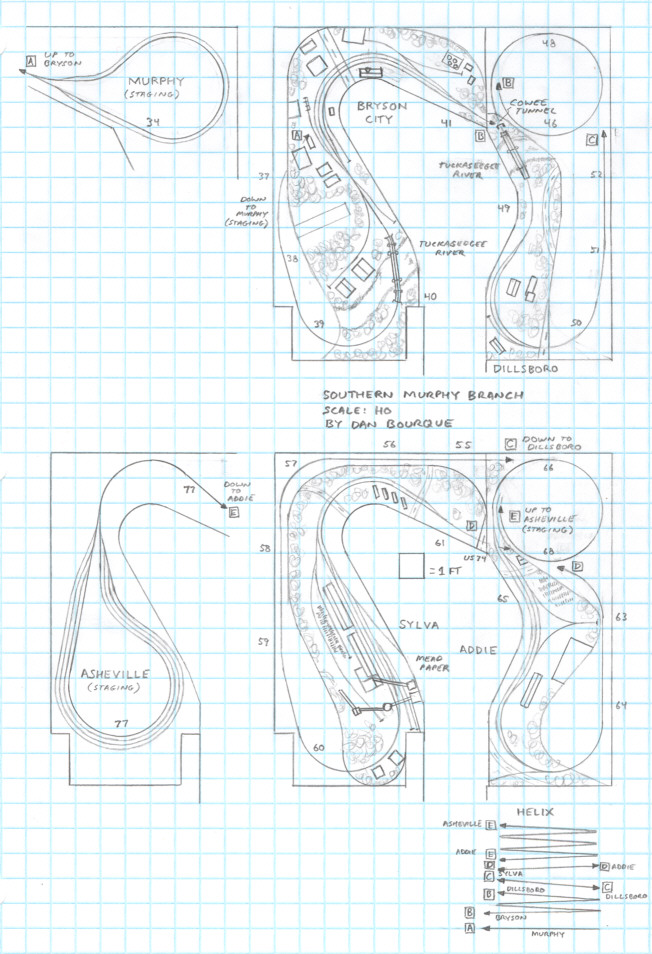- Size: 13′ x 14′
- Scale: HO
- Minimum Mainline Radius: 24″
- Minimum Aisle Width: 30″
- Designed by Dan Bourque
 While not a coal branch, the Southern’s Murphy Branch in western North Carolina was certainly set in the Appalachians. The branch, which struck out westward from the Southern’s large yard at Asheville, NC, was loaded with great Appalachian industries such as pulpwood loading, paper mills, coal dealers, fuel oil dealers, furniture plants, etc. and even an interchange with the L&N’s own Murphy Branch at the line’s terminus in Murphy, NC. The use of old F-units and first-generation geeps into the early ’70s added to the branch’s charm in the diesel era.
While not a coal branch, the Southern’s Murphy Branch in western North Carolina was certainly set in the Appalachians. The branch, which struck out westward from the Southern’s large yard at Asheville, NC, was loaded with great Appalachian industries such as pulpwood loading, paper mills, coal dealers, fuel oil dealers, furniture plants, etc. and even an interchange with the L&N’s own Murphy Branch at the line’s terminus in Murphy, NC. The use of old F-units and first-generation geeps into the early ’70s added to the branch’s charm in the diesel era.
The Layout
The Murphy Branch was long, so this bedroom-sized layout focuses on a few key scenes along the middle of the Branch where a lot of switching occurred. It is designed as a series of four vignettes at different levels connected by hidden track and short helixes. The two main scenes are Bryson City and Sylva–both towns were home to industries and local crews in the late ’60s/early ’70s when the layout is set. The first deck is Bryson City, and most of the industries including the Singer furniture plant, a coal trestle, a fuel-oil dealer and a grocer are represented along with the station and tiny 3-track “yard”. The second deck represents Dillsboro and is the most scenic level with its bridge over the Tuckaseegee River and the Cowee Tunnel. Also included is a short siding and a spur where a local quarry loaded stone into gondolas. The third deck (above Bryson City) is Sylva, home to the Mead paper plant with its many tracks. The fourth and final deck represents Addie, home to a lumber plant and later an Olivine (stone) mine.
The run from Bryson City to Addie (visible areas plus hidden linking tracks) is more than 130-feet long–that’s a lot of railroad for a bedroom! The east and west ends of the Murphy Branch are represented by staging: four tracks represent Asheville/Canton to the east, and two tracks represent Murphy to the west. Only one train needs to be staged in each yard for an operating session, so the other tracks can be used for storage. One unconventional design element is an upper-level staging yard for Ashville at 77″. This was done to avoid too long a run between the visible portion of the layout and staging, but the plan could be modified to use a two-track helix with the inside track taking trains down to an Ashville staging yard under the layout instead.
Because this layout would host multiple trains, DCC is a must. A starter set would provide ample command power for the handful of locomotives, but a booster would likely be needed because of the amount of track and possibility of running several locomotives at once.
Operations
Operations during the late ’60s/early ’70s would be very interesting and keep a couple of operators busy for a couple of hours. Four trains would work this section of the railroad. The first train would be the “Blue Goose” from Asheville staging powered by a set of Southern F-units. The Goose would bring in cars bound for Sylva and points west including Bryson City and Murphy. After dropping its cars at Sylva and pulling any ready cars from the Mead paper tracks, the Goose would turn back toward Asheville, stopping briefly to drop off and pick up cars at Addie.
In the meantime, the Bryson-Sylva turn would fire up its power, probably an F-unit and a GP7, sitting by the station in Bryson City. The turn would collect cars from the local industries, set out any Murphy-bound cars in one of the yard tracks and then head east with any Dillsboro, Sylva, Addie, Canton or Asheville-bound cars including any brought in from the L&N interchange at Murphy the day prior. The turn would leave its cars at Sylva in exchange for any Bryson City or Murphy-bound cars set out by the Goose or the Sylva Switcher. Upon returning to Bryson City, the turn would finish its switching chores by spotting cars at the local industries: boxcars for the furniture plant, tank cars for the oil dealer, an occasional hopper for the coal dealer and a reefer or insulated boxcar for the grocer.
While the Bryson-Sylva turn is away in Sylva, the Murphy-Bryson turn hauling Southern and L&N pulpwood racks and a few other miscellaneous cars behind a pair of 4-axles would depart Murphy staging for Bryson City. In Bryson, the train would drop its cars, mainly pulpwood loads bound for the paper mills at Sylva or Canton, and pick up the Murphy-bound cars set out by the Bryson-Sylva turn earlier before returning to Murphy.
The final job is the Sylva Switcher. This job, powered by a GP7 or GP9, would spend its day switching the industry tracks at Sylva, Dillsboro and Addie spotting the cars dropped by the Goose at Sylva and Addie and lining up cuts of cars for the Goose to take back to Ashville or the Bryson-Sylva turn to take west.
For variety, a mid-’70s era operating session would be quite a bit different. The Fs and GP7s/9s would be replaced by GP38s and the occasional GP30 or 35, and only two sets of power would be needed. The Goose would still forward cars to Sylva, but the Bryson power would be used for a morning Bryson-Addie turn to work all the industries on the layout and then recycled in the evening for a Bryson-Murphy turn. This train could be staged mid-job in Murphy to begin the session, then work Bryson-Addie-Bryson, then return to Murphy staging at the end of the session.
You can’t ask for much more operation out of a bedroom-sized layout than that! I’d like to thank Jim King for supplying the track diagrams and the descriptions of trains for this layout. Any disparities between the way the actual trains worked and the jobs described here are my fault as I simplified them a bit to fit the layout.
Things I Like About this Plan:
- Lots of running in a small space
- Double-decked with no more than two-turns in a helix at a stretch
- Lots of switching
- Plenty of trains working the line
- Wide operating aisle
- Neat scenery mixed in with industries to capture feel of area
Things I Don’t Like About this Plan:
- Small minimum radius (24″)
- Lots of hidden track
- Upper-level staging tough to access
- Scenes pretty compressed
Related Products:




